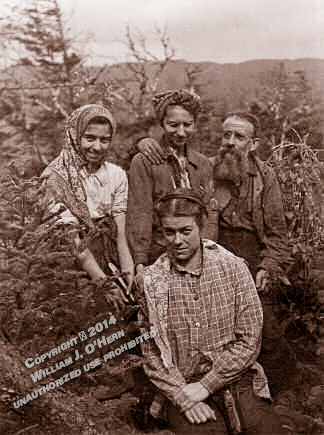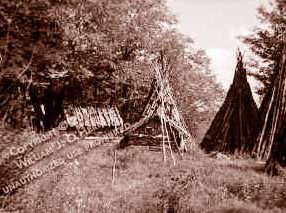My first trip into Noah John’s [Cold River Hill] hermitage came following our successful assault of the four summits in the Seward Range.

The Hermit and Us – Our Adirondack Adventures with Noah John Rondeau
Helen’s First Trek to Cold River Hill
An excerpt from “The Hermit and Us”, Starting on page 115
Several of Helen’s letters recall the unlikely first meeting between the Colyer girls, their hiking companion and friend Ruth Prince, and Rondeau. It all began on a backpacking trip in the Adirondacks. Mary, “Ruthie” Prince, Bess Little, and Helen had climbed Seymour, Seward, Donaldson, and Emmons, the four high peaks in the Seward Mountain Range in May 1942. The cast of characters assembled at the hermitage on June 20th for an earnest assault on Couchsachraga Peak. The mustering was a mind-tingling, never-to-be-forgotten event for the women, one they often talked about through the years that followed.
I’ll let Helen tell their story.
The hermitage was a good eight miles away. We shouldn’t have left her alone in the woods, but we were young and didn’t give any thought to any possible danger.
My first trip into Noah John’s hermitage came following our successful assault of the four summits in the Seward Range. Bess hurt her ankle bushwhacking down the steep, often rocky descent off Seward Peak. She never uttered a word of pain nor mentioned the injury until we arrived back at Ward Brook lean-to, site of our temporary encampment.
We had planned to go to Noah John’s the next day. Bess persuaded us to leave her alone at the open camp. She was disappointed she had lost her footing and had injured her ankle. The swelling was pronounced. She was realistic. Rest was needed. She wouldn’t be able to hike out to the trailhead in her condition, so her persuasiveness for us to continue with our plan made sense. In fact, Bess insisted we carry on with the original plan of climbing Couchsachraga. She had a Readers Digest to idle the hours away. Now that I think of it, we should have stayed with her. The hermitage was a good eight miles away. We shouldn’t have left her alone in the woods, but we were young and didn’t give any thought to any possible danger. We were comfortable in the woods.

Courtesy of Edward J. Fox
Noah’s bailwick of wigwams was a refuge for Helen, Mary and Ruthie.
I have no idea the exact time of day we arrived at the hermitage. Noah acted tickled pink at hearing the name Colyer. He told us he once helped our father with a deer near Calkins Brook many years earlier. [The hermit] gave us the ‘grand tour’ of his so-called ‘city.’ He showed us his wigwams, and the gardens where he grew potatoes, carrots, sweet peas, pansies and foxgloves. The ‘Beauty Parlor’ stood ready for customers. The ‘Town Hall’ cabin in which Noah lived was small. His bed was on one side. There was a bookshelf over the bed. It held Pilgrim’s Progress, the Bible, a book on astronomy and another book. He had no table or chair. He told us that in winter he sat on the bed to cook. He ate from the stove so that he’d have hot food. All of his wood was pre-notched and piled teepee style so that he could get it when the snow was deep.
The teepee-type buildings, or ‘wigwams’ as he also called the hollow interior cone-shaped stacks of poles he prepared for future firewood, had names. The number of them varied from three to five. There were so many poles leaning together they were almost rainproof. The Trap Wigwam housed, as you might have guessed, steel traps. They hung from rings that were held by nails. He said it was used for sleeping quarters when he had an overflow crowd of guests. Mrs. Rondeau’s Kitchenette was another wigwam. It had a fire pit inside. The inside back of the wigwam was piled with stones and a stone-lined hearth. He cooked in there when it rained or whenever the weather was too cold to be out of doors. His kettles were suspended over the pit by chains that were attached far above where the poles interlocked. There were buckets, empty Beechnut coffee cans, a big pan for dishwashing, a small table, and other things inside.
Courtesy Helen C. Menz
Background picture – Foreground: Helen Colyer; Lt. to Rt.; Mary Colyer, “Ruthie” Prince and Noah. Couchsachraga Peak, 1942. Noah wrote in a letter to Mary dated April 8, 1943: “…the four in the picture are not escaped Russian Refugees as You suppose… I’ll let you in on it a bit, the way they got to the Mountain Top was eating bread and Candy and drinking Lemonade…” [protected from insects with a] “diffused odor of Happy-Medium-Blend-of Kerosene, Citronella and Pine-Tar. It was captivating beyond all powers of resistance.”